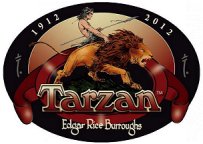Perhaps you didn’t know that this chest-thumping,
bellowing ape man, swinging from limb to limb through twenty volumes of
African adventure, has added a new word to the American language. And that
two U.S. post offices have been named for him – one in Tarzan, Texas, and
one in Tarzana, California.
And that he is the basis for a phenomenal business corporation with ramifications
all over the world. Conceived one sleepless, sultry,
summer
night in Chicago by Edgar Rice
Burroughs, then a struggling
author, he has now become a legend. The first Tarzan story (Tarzan
of the Apes), written as a serial in 1912
was rejected by almost every book publisher in the U.S., until it was finally
published two years later by A. C. McClurg & Co.,
and rocketed to a peak of over 3,000,000 copies. Forty-Seven
novels by Author Burroughs have followed it --- representing an estimated
sale of 25,000,000 books and including best sellers in eighteen languages.
On the flood tide of his royalties from Tarzan
of the Apes, Author Burroughs moved west and purchased a ranch, which he
named “Tarzana,” about
fifteen miles from Hollywood. Thereafter, as one best seller followed another,
he became increasingly involved with the byproducts that sprouted from
these successes – magazine rights, newspaper-serial rights, foreign book
rights, dramatic rights, radio rights, comic strip rights, and merchandise
rights. To protect and handle these properties Author Burroughs formed
a corporation in 1923, consisting of himself as President, Son Hulbert
and shrewd publishing associate, C. R. Rothmund, as Directors. It seemed
a pity to have to split royalties with any publisher of the seventy-five-cent
reprint editions of his books, all of which were still in print and selling
in enormous quantities. Therefore Mr. Burroughs decided to publish the
original $2 editions himself, with the result that two new Burroughs novels
are now issued by the corporation each year.
And then there are the movies. In 1936 the
Burroughs corporation contracted with Independent Producer Sol
Lessor to make five Tarzan pictures during the ensuing five years.
There had been thirteen
already – some of them, according to Mr. Burroughs, pretty
terrible. But they all made money, with an estimated total gross of
over $20,000,000. The first Tarzan was Elmo K. Lincoln,
in the old silent days; by far the most successful was lank-haired Johnny
Weissmuller; the most recent was newly discovered He-man Glenn
Morris in the first of the Sol Lessor pictures. Metro-Goldwyn-Mayer
has made the best three pictures to date, at a cost of about $1,000,000
each. Each took from one to two years to complete, required six hundred
people and a menagerie of wild animals.
Tarzan has found another prodigious audience
on the air. Mr. Burroughs has contracted with an independent radio
producer to furnish a series of Tarzan records
based on the original stories. Three
programs, consisting of 364
fifteen-minute episodes, have already been recorded and sold to sponsors
and stations all over the country, to the accompaniment of a terrific ballyhoo.
Approximately 1,000,000 Tarzan statuettes
have been given away as premiums to sponsors. More than 50,000,000 Tarzan
ice-cream cups and 75,000,000 loaves of Tarzan Bread have been sold
on a royalty basis. Indeed, the merchandising plan attached to the tradename
of Tarzan is one of the most phenomenal by-products of the whole business.
There are Tarzan schoolbags,
penknives, sweaters, masks, paint books, candies, chewing gums, toys, jungle
costumes. And all of them pay royalties to Edgar Rice Burroughs, Inc.
Lastly, there are the Tarzan
comic strips – the daily strip and the Sunday
full page in color – one of the most popular of all the features syndicated
by the United Features Syndicate, Inc. Many newspapers fold their Sunday
editions with Tarzan on the outside, as a circulation booster. These features
boast a total sale to 291 newspapers with an aggregate A.B.C. circulation
of 15,672,000 exclusive newspapers in twenty-eight foreign countries.
BUT the Burroughs corporation doesn’t depend
entirely upon Tarzan for its subsistence. There are real-estate investments,
for instance, that have a present valuation of well over a million dollars.
The former Tarzana Ranch has been sub-divided
into lots and has become the thriving township of Tarzana. The office
building of the corporation is still
located there, but Mr. Burroughs lives at Malibu among
the film people. Here he does much of his writing, rides horseback,
plays tennis, and indulges in private flying, which
he took up at the age of fifty-eight. He admits that some
of his stories are not
so hot but reminds you pertinently that they sell – an argument that
admits of no rebuttal.




![]()

![]()
